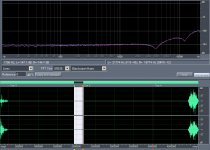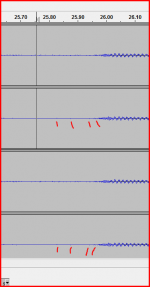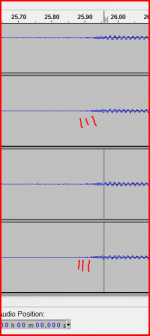The reason I compared TL072 and TLE2072 was because I had a feeling that these 2 opamps had the biggest sound difference (in fact, I had no mistake in differentiating Mark Knopfler's husky voice either in ABX test mode or training mode). And because I have put TL072 on the top of my preference list and TLE2072 on the bottom of my preference list.
I'm a believer in amplifier topology and simplicity (see attachment).
I can't disagree over the TL072 being a remarkably good device, but saying that is at odds with the fact I struggled to get statistically significant test results comparing these devices.
I failed the identifying characteristics test, as I picked Violet (TLE2072). In the first run I liked LM833P.
But thanks very much for the effort. 🙂
Regards.
Thanks, pleased you enjoyed it.
Yep, exactly the sort of stuff expected.
Mooly,
I think a complete rewind and reset is in order with new recordings. Otherwise Jay's fantastic comments are worthless.
Time is always the problem on any marathon test like this. It would be interesting though.
Jay... do you think you could pick the TL072 out again if we ran the TL072 against your choice of another opamp ?
Just two files... you guys can choose the circuit configuration and values.
I can't disagree over the TL072 being a remarkably good device, but saying that is at odds with the fact I struggled to get statistically significant test results comparing these devices.
I have mentioned in the blind test, that the TL072 indeed had an issue. It was the relatively high noise. But this noise didn't affect my preference. This noise might be able to be suppressed with better circuit implementation, or it might be part of the chip specification. IIRC, TI main objective with TLE207x was to fix this noise issue with TL07x.
I think the reason TI didn't show THD+N (but just THD instead) in the datasheet was because this noise could be high?
Jay... do you think you could pick the TL072 out again if we ran the TL072 against your choice of another opamp ?
Just two files... you guys can choose the circuit configuration and values.
As I have suspected and turned out to be so, TL072 and TLE2072 were very different. I can use the husky voice as a reference to pick out the TL072. I suspected that LM883P is the closest with TL072 (Remember, I put TL072 in position #1 and LM883P in #2).
NE5532 is very good and it differs only in its fatiguing aspect, which I need to "feel" within may be at least 20 minutes of listening! So it will be difficult I guess.
Basically I can try any opamp you want to compare, whatever the difficulties. I have a feeling that I can find the difference, only time to find where the difference is. Of course, the music should be specific. Some special male vocals are difficult to reproduce, and some instrumental music must have that special timing or pace so the musicality can be different from one opamp to another. And I think the Dire Strait (or Mark Knopfler) is perfect, and as a plus, I'm also very familiar with how they sound.
OK, I'll see if I can come up with something over the next few days. It would be very interesting to see if these differences are repeatable with another track and so on.
I have mentioned in the blind test, that the TL072 indeed had an issue. It was the relatively high noise. But this noise didn't affect my preference.
This reminds me of a simple LTP-input amplifiers. With simple LTP, the noise is high but the sound is very musical. When you add current mirror (or constant current source), the objective noise performance is improved but you lost the musicality.
Look at the STK chip amps. The ones with current mirrors have better spec but not as popular as the basic ones, because the more advanced ones do not sound as musical.
It doesn't mean that simple is better, but it takes more than just simple skill and knowledge to make complex things better at every aspects.
Jay, you read a different CFA debate than I did then
I forgot where your position was in the debate 😀 No, I'm not a CFA fanboy. But yes, I have worked almost exclusively with CFA topology during the last few years.
I have made really excellent technical performing composite amps with TL072 input (a least for cheap prototyping, debugging) and several different full complementary bipolar semi process modern monolithic VFA as well as CFA buffer/output amp stages
Is that amplifier for share? I have frequently tried similar to Apex A9, or HAL OPB if I'm not mistaken. But it is very difficult for me, because the opamp models for amplifier simulation seemed do not work well.
Maybe you would like the LM3900 quad opamp 😉 A very very old but fascinating device.
Is that quad version of LM301? I have never heard of LM3900 but I have plenty of LM301 in steel package.
I thought the files were trimmed and renamed. Not valid for a second round?
It took just a couple of minutes for identification of RED via comparison to first set of clips and provided key.
Is that quad version of LM301? I have never heard of LM3900 but I have plenty of LM301 in steel package.
Nothing like. In fact they don't even behave as 'normal' opamps.
Nothing like. In fact they don't even behave as 'normal' opamps.
Wasn't aware of this chip and it is a funky beast indeed, very interesting input stage.
It was quite something back in the day. There used to be whole books available, full of projects for this chip. 50 projects for the LM3900 😀
Nothing like. In fact they don't even behave as 'normal' opamps.
Eww! I didn't notice the very simple circuit! Hmmm... so this is an old chip. May be I have seen it before in one of my stuffs, if it was that popular. Will keep an eye on them...
How so? By listening, or by looking at the files somehow?It took just a couple of minutes for identification of RED via comparison to first set of clips and provided key.
I thought the files were trimmed and renamed. Not valid for a second round?
I had a try myself to crack them and found it was pretty easy, even using Audacity. Pick a quiet section and you can match one file from one set to the corresponding file in the other visually.
First image TL072 master file and 'Red'. Its a match. Second is 'Red' (edit... actually TL072 master) vs 'Blue' as an example, different.
Attachments
Pick a peaking transient and working from peak values or local zero crossing makes visual ID straight forward. With a little more manipulation subtraction yields result showing dither and noise shaping used during file production:

For the above pic file A is subtracted from RED file. Opening and closing seconds of result are do to something with Mooly's production. All other pairings of first run subtracted from second run produced similar results; all mis-pairings produce much higher apparent noise floor.

For the above pic file A is subtracted from RED file. Opening and closing seconds of result are do to something with Mooly's production. All other pairings of first run subtracted from second run produced similar results; all mis-pairings produce much higher apparent noise floor.
Interesting, thanks 🙂 I always do a fade in and fade out at the start of tracks (5 seconds at each end).
I think that's great though, and certainly lessons learned... you are way more into this than myself.
I think that's great though, and certainly lessons learned... you are way more into this than myself.
- Status
- Not open for further replies.
- Home
- General Interest
- Everything Else
- Listening Test. Trying to understand what we think we hear.

